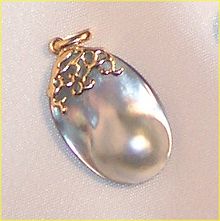Mabé pearl
Mabé pearls are a form of cultured pearls. They are also known as cultivation shell or cultivation blister pearls. These names can be traced back to the special cultivation process of the Mabé pearl, which can be traced back to the 13th century in China.
origin
Mabe-gai is the Japanese name for the shell species Ptera penguin . In international trade, this species is also known as “Blacked Winged Oyster” or “Black Butterfly”. These names can be traced back to the shape and the dark shell body, which can be up to 25 cm long.
The name Mabé (pronounced "Mah-bay"), which is common in the jewelry trade, is derived from Mabe-gai. Ptera penguin is good for growing shell pearls, but not for growing full pearls. 75% of Mabé pearl production is grown in these shells, mostly in Japan, China, Indonesia, Australia and the Philippines.
Other suitable types of mussels are Ptera sterna ("Rainbow Lip Oyster") and Pinctada maxima . Breeding areas for these species are Tahiti, the Philippines and the Gulf of Siam .
rearing
In contrast to the round cultured pearls, which develop in the connective tissue in the middle of the mussel, small hemispheres made of clay, plastic or mother-of-pearl are used between the shell and the coat to make Mabé pearls . After a short time, the kernels used are covered with a fine layer of pearl substance and have grown to the shell. The developing pearls have to stay in the shell for 6–12 months until a solid layer of mother-of-pearl about 0.7–1.5 mm thick has formed around the respective core.
As long as the pearl is still in the shell, it is called a "blister" (English for "skin bubble") or "bubble pearl". The semicircular pearls are cut out of the shell, the foreign bodies are removed and replaced with a turned mother-of-pearl core. A slightly curved mother-of-pearl disc is glued to form the bottom. This creates an almost lens-shaped cross-section of the pearl. The flat underside is then either covered with a piece of mother-of-pearl and left in a hemispherical shape or supplemented with a layer of mother-of-pearl to form a fully round ball.
features
The majority of Mabé pearls are white or cream-colored, but black Mabé pearls are also grown. The surface is mostly flawless and has a strong, silky and rainbow-colored sheen. While most cultured pearls reach a diameter of 4 to 12 mm, the Mabé pearls are preferred with sizes of 10 to 20 mm. Sometimes Mabé pearls reached a diameter of 25 mm.
Jewelry making
Because of their special shape and size, Mabé pearls are preferred for making rings, necklaces and earrings. Jewelry with Mabé pearls is usually classified in the middle price segment.
literature
- Elisabeth Strack: Pearl Brooch. Stuttgart: Rühle-Diebener 1982. ISBN 3000086366

